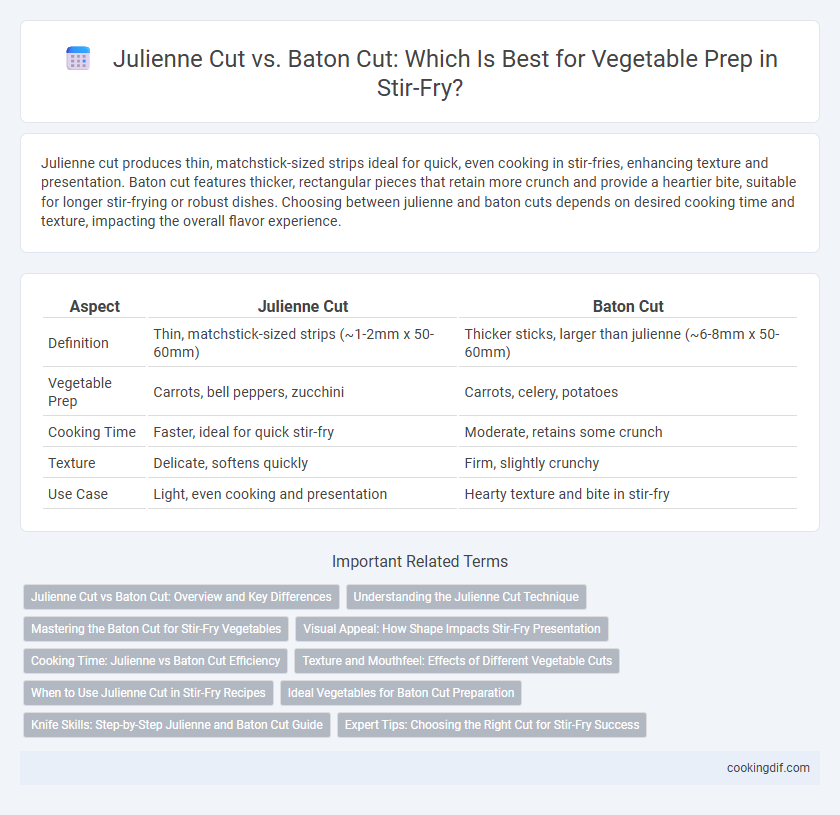Julienne cut produces thin, matchstick-sized strips ideal for quick, even cooking in stir-fries, enhancing texture and presentation. Baton cut features thicker, rectangular pieces that retain more crunch and provide a heartier bite, suitable for longer stir-frying or robust dishes. Choosing between julienne and baton cuts depends on desired cooking time and texture, impacting the overall flavor experience.
Table of Comparison
| Aspect | Julienne Cut | Baton Cut |
|---|---|---|
| Definition | Thin, matchstick-sized strips (~1-2mm x 50-60mm) | Thicker sticks, larger than julienne (~6-8mm x 50-60mm) |
| Vegetable Prep | Carrots, bell peppers, zucchini | Carrots, celery, potatoes |
| Cooking Time | Faster, ideal for quick stir-fry | Moderate, retains some crunch |
| Texture | Delicate, softens quickly | Firm, slightly crunchy |
| Use Case | Light, even cooking and presentation | Hearty texture and bite in stir-fry |
Julienne Cut vs Baton Cut: Overview and Key Differences
Julienne cut involves slicing vegetables into thin, matchstick-like strips typically measuring about 1/8 inch by 1/8 inch by 2 inches, ideal for quick, even cooking in stir-fry dishes. Baton cut produces thicker, stick-shaped pieces approximately 1/4 inch by 1/4 inch by 2 to 3 inches, offering a crunchier texture that holds up well during higher heat cooking. The choice between julienne and baton cut affects cooking time and mouthfeel, with julienne favoring tenderness and baton cut enhancing crispness in stir-fried vegetables.
Understanding the Julienne Cut Technique
The julienne cut technique involves slicing vegetables into thin, uniform matchstick-sized strips, typically about 1/8 inch wide and 2 inches long, optimizing even cooking in stir-fry dishes. Compared to the baton cut, which produces thicker and chunkier pieces usually around 1/4 inch by 2-3 inches, julienne cuts ensure quicker heat penetration and a crisp-tender texture. Mastering the julienne cut enhances stir-fry presentation and guarantees balanced cooking times for diverse vegetables like carrots, bell peppers, and zucchini.
Mastering the Baton Cut for Stir-Fry Vegetables
Mastering the baton cut for stir-fry vegetables enhances even cooking and presentation by creating uniform, rectangular sticks typically measuring 1/4 inch by 1/4 inch by 2 to 3 inches. This precise cut ensures vegetables maintain their texture and crispness when stir-fried at high heat, unlike the thinner, finer julienne cut which may cook too quickly and lose firmness. Optimal baton cuts for vegetables like carrots, bell peppers, and zucchini improve heat distribution and make stirring easier, resulting in a perfectly balanced stir-fry dish.
Visual Appeal: How Shape Impacts Stir-Fry Presentation
Julienne cut vegetables create thin, matchstick-like strips that enhance stir-fry dishes with a delicate, elegant appearance, making the meal visually appealing and refined. Baton cut vegetables, with their thicker, rectangular shapes, provide a bold and hearty aesthetic, contributing to a more substantial presentation in stir-fry bowls. Choosing between julienne and baton cuts influences not only texture and cooking time but also the overall presentation, tailoring the visual impact to suit different culinary styles.
Cooking Time: Julienne vs Baton Cut Efficiency
Julienne cuts, measuring about 1/8 inch thick and several inches long, cook faster due to their thin, uniform size, making them ideal for quick stir-fry methods. Baton cuts, thicker and chunkier (approximately 1/4 inch to 1/2 inch), require longer cooking times to ensure even tenderness and flavor release. Choosing julienne cuts enhances efficiency in high-heat stir-frying by reducing overall cooking time without sacrificing texture or taste.
Texture and Mouthfeel: Effects of Different Vegetable Cuts
Julienne cuts create thin, matchstick-like strips that cook quickly, resulting in a tender yet slightly crisp texture ideal for stir-fry dishes. Baton cuts produce thicker, rectangular pieces that offer a more substantial bite and firmer mouthfeel, maintaining vegetable integrity during high-heat cooking. Selecting between julienne and baton cuts directly influences the overall texture contrast and eating experience in stir-fried meals.
When to Use Julienne Cut in Stir-Fry Recipes
Julienne cut vegetables, thin and matchstick-sized, are ideal for stir-fry recipes that require quick cooking and even heat distribution. This cut is perfect for ingredients like bell peppers, carrots, and zucchini when the goal is to achieve a tender-crisp texture without overcooking. Using julienne cuts ensures the vegetables blend seamlessly with protein and sauces, enhancing both presentation and flavor absorption.
Ideal Vegetables for Baton Cut Preparation
Baton cut vegetables, typically measuring about 1/4 inch by 1/4 inch by 2-3 inches, provide a uniform size that ensures even cooking in stir-fry dishes. Ideal vegetables for baton cut preparation include carrots, zucchini, bell peppers, and celery, as they retain a pleasant crunch and absorb sauces effectively. This precise cut enhances texture and presentation while maintaining optimal cooking time.
Knife Skills: Step-by-Step Julienne and Baton Cut Guide
Mastering knife skills is essential for stir-fry, with julienne and baton cuts providing precise vegetable preparation for even cooking. The julienne cut produces thin, matchstick-shaped strips approximately 1/8 inch wide and 2-3 inches long, ideal for quick, uniform cooking in high heat. Baton cut is thicker, about 1/4 inch by 1/4 inch by 2-3 inches, offering a chunkier texture that retains more crunch and body in stir-fried dishes.
Expert Tips: Choosing the Right Cut for Stir-Fry Success
Julienne cuts, thin and uniform strips measuring about 1/8 inch by 2 inches, ensure quick, even cooking in stir-fries, preserving texture and flavor. Baton cuts, thicker and chunkier at roughly 1/4 inch by 2 to 3 inches, provide a heartier bite and hold up well with longer cooking times or stronger sauces. Expert chefs recommend matching the cut size to the vegetable's density and desired cooking time for optimal stir-fry results.
julienne cut vs baton cut for vegetable prep Infographic

 cookingdif.com
cookingdif.com